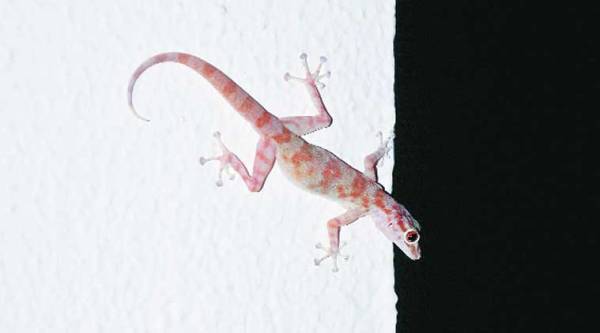Lizards are friendly creatures with happy eyes and a positive outlook
Lizards are friendly creatures with bright, happy eyes and a positive outlook. So why are you scared of them?
 It’s amazing so many people are terrified of lizards.
It’s amazing so many people are terrified of lizards.
It’s amazing so many people are terrified of them. Time and again, I’ve opened the front door, answering a tentative ring, and found visitors hovering at the edge of the porch smiling sheepishly and pointing towards the porch light.
“What’s the matter?”
“There’s a lizard…”
“Oh, you mean the gecko. It’s harmless!”
They scurry in and God help them (and you) if there’s another one hunting on the drawing room ceiling. You’d think you had invited them to get cozy with a brace of Komodo dragons. And it’s amazing because I’m sure every house has its gecko tenants. They’re friendly, mushroom-coloured creatures, with bright, happy eyes and a very positive outlook to life. They emerge from their hideouts when the lights are switched on and assiduously patrol their territories — say, your drawing room ceiling. It’s an education watching them hunt.
A moth, or beetle will blunder in, spin dizzily around the room several times before settling down. The gecko will notice it at once, and bob its head. The moth will settle close to its favourite light, and the hunt begins: quick spurts of sprinting interspersed by pauses. Then, as it draws closer, it goes into its leopard’s stalk. Millimeter by millimeter it draws closer, there’s a lightning lunge, a snap and pop and the gecko is happily stuffing its face with moth or beetle, nodding his head in approval. Delicious!
They’re excellent pest-controllers. Flies, mosquitoes, termites, cockroaches — any insect that settles on the wall is game. Early one morning, I met one who had tried tackling a humungous cockroach, probably some time during the night. The roach was clearly too big to swallow — only its head and part of its thorax were in the gecko’s mouth, and matters were at a stalemate — and remained so for a couple of hours. Eventually, the gecko figured it could not swallow a whale in one gulp and spat it out. But, it’s the spirit that counts.
They’re fiercely territorial. Let another gecko show its face and it will be tackled straightaway and shown the door. Sometimes, the challenge is taken up and battle commences. These can be bloody and, usually, the loser will flee using the gecko’s time-honoured distraction device. For us, dropping a heavy name may be the way out of a traffic offence, the gecko drops its tail and flees. The abandoned tail wriggles and squirms, distracting the enemy. A new tail eventually grows back, just another of the magic tricks the gecko has up its sleeve.
Its piece de resistance is, of course, the way it scuttles up vertical walls and across glass ceilings without falling into your soup. Sticky fingers eh? Apparently the gecko’s toes have millions of tiny hairs, which in turn are split into millions more which have flat caps at their tips (called spatulae), which use the force of molecular attraction between surfaces, coupled with their relatively large surface area, to enable the gecko to cling on and even support 50 times its own body weight while upside down! Feverish attempts are on, no doubt, so that we can emulate that — with special footwear perhaps. Good for window cleaners and firemen, but a nightmare if cat burglars get a hold of it.
Geckos lay eggs in quiet dark niches and the mother will guard them stoically till they hatch. The babies are ugly and squiggly and can give geckophobics heart attacks when they wriggle frantically out of sofa cushions and over their laps! And leave them a wriggly tail as a take-home souvenir.
Ranjit Lal is an author, environmentalist and bird watcher
E-mail author: ranjitlal55@gmail.com
The story appeared in print with the headline Sticky Fingers
- 01
- 02
- 03
- 04
- 05



























